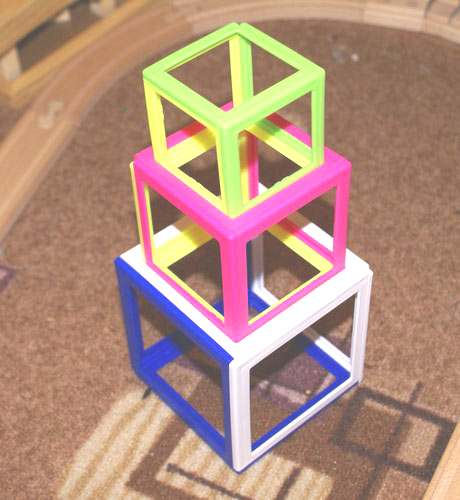You can make great cubes with Tako.
Tako is another vintage building set. Its pieces are thin, open frames of different colors and sizes. All these frames have square shapes, and they connect to each other by the edges, forming all kinds of shapes. The manufacturer mostly proposed abstract geometric shapes as possible crafts, but these shapes look pretty, and you can use them to play along with some other toys.
Tako frames connect by the edges – they have tiny rails and empty spaces along the edges to put those rails in. As you can see, the edges are slightly asymmetrical, because the two sides of the square have the rails, and the other two have empty spaces. Sadly, the number of ways you can connect the pieces is limited. Many modern building sets offer more options. Of course, the pieces of the same size hold together the best. The pieces are beautiful but delicate and fragile – they can bend slightly, but they are also relatively easy to break accidentally.
Since all pieces are squares, the basic figure you can assemble is a cube, but it’s also possible to make prisms and other figures. They, however, are more tricky to assemble. The set has pieces of 4 different sizes and 6 colors.


Jane, please tell me – do cubes from these frames hold up well, don’t they fall apart in your hands? And another question – in a tower like the one in your photo, don’t the upper cubes fall inside the lower ones, is there some kind of device for firmly securing them at the top? I looked at this set pieces online for some time website, but I still don’t quite understand how it works.
The cubes are very durable. I can’t even say yet at what age a child will be able to close the last edge (a 3-year-old definitely can’t, he connects two squares with one side for now).
– The cubes are strong. They are tough connect with each other, and hold on tightly (maybe when they come loose with time)
-The ladder from the other photo is flimsy and sways.
-Prisms, as I already wrote, did not work out for me. My son likes to play with the collected cubes and make patterns from the squares. Overall, it seemed to me that this constructor is best suited for exactly this: comparing colors and sizes. Something specific (except for cubes and a house with an overhead roof) is difficult to build. The instructions suggest some different game options:
– collect cubes and build something from them: pyramids, letters, cubes in a cube.
– play with square frames: make patterns, select frames by size, color; collect smaller frames inside a larger one.
– at the end of the book there are descriptions of games with dice:
* guess the color
* guess your color when rolling the dice
* Guess where each color will come up when throwing the dice.
In general, they approached the creation of the instruction manual very seriously, even though they tried to make a joke in the preface, describing the use of the constructor as in an instruction for a medicinal product :-))
Thanks for such a detailed explanation! Jane, so the cubes of different sizes are simply inserted into each other and they can be installed at any level, did I understand correctly?
Yes, the cubes are simply inserted into each other, they aren’t especially fixed in any way. Moreover, they hold tighter at the top and bottom, closer to the top and bottom edges of the inserted cube. In the middle position they are quite loose, so they can slide.
Interestingly, we made the prisms very easily. My husband did, anyway :))
Your husband did great job! :))) But I’m afraid to try again – it seems like there’s no need for now, and I don’t want to break any more squares…